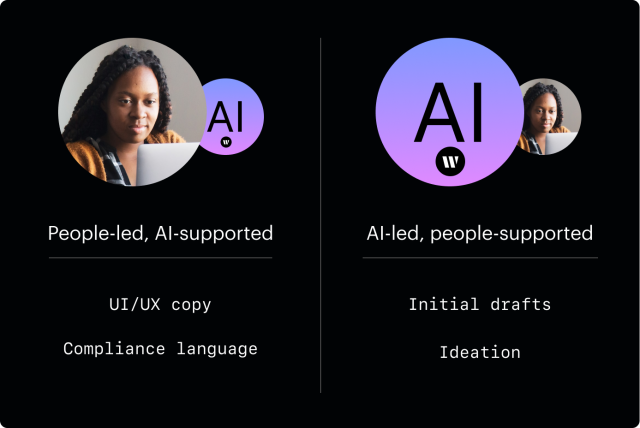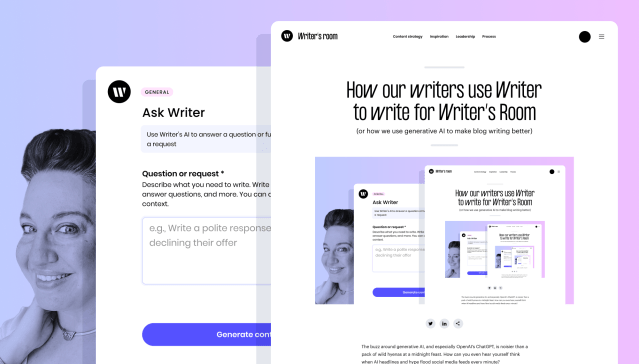- story – 5 min read
- AUDIO – 29 min
Building Neo from the brand up
Delphine Lavy & Sam Cheung on scaling
language, brand, and product at Neo Financial

content marketing
development time
employees
Listen to Neo Financial’s story or read the (edited) transcript below
WRITER is the full-stack generative AI platform for enterprises. We make it easy for organizations to adopt AI apps and workflows that deliver quantifiable ROI quickly.
WRITER helps organizations build highly-customized AI apps that compress entire business processes, support complex use cases, and infuse work with company intelligence. Our enterprise-grade platform can be deployed flexibly, keeps your data private, and adheres to global privacy laws and security standards. Leading enterprises choose WRITER, including Vanguard, Intuit, Accenture, and Kenvue.
Sam Cheung is manager of product design & UX writing and Delphine Lavy is creative content lead at Neo Financial, Canada’s fastest-growing fintech unicorn. Read or listen to the story of how Sam and Delphine accelerated Neo Financial’s content production processes across both marketing and product by aligning team members on company language and accelerating content writing with AI.
The Neo Financial team uses WRITER to:
- Automatically generate first drafts of blog posts, long-form creative content, lifecycle email, and social ad copy
- Automatically enforce brand, terminology, and compliance requirements across marketing and product content
- Free up time so writers can enable non-writers to edit and review their own work, freeing writers to work on other high-impact projects
Let’s start with the Neo Financial brand. How has it evolved since you started at the company?
When I first started three years ago, Neo really was just starting as a company. We were still trying to figure out what our identity was. Over the first year and a half, it was a lot of trial and error, both on the design side and the content side. Trying to figure out who Neo is.
Neo provides a holistic financial suite for Canadians. But what does that mean for us? How do we want to represent ourselves in the market? We knew that we wanted to be unique from what people traditionally saw in financial services, but at first it was just trying out different kinds of design patterns, different types of writing styles, and voices.
And I’d say that what’s changed now is that we have a clear brand path and vision, and our approach to brand development is a lot more mature. We’ve grown the team exponentially and brought on people who can execute on that brand.
And I think something to note is that it’s not just the product driving the brand. It’s both ways. So our brand purpose is driving some of the products and features that we’re building and we’re able to think more critically on both sides.
I’d add that because now we’re in a position where our brand has matured and we think about the brand all the time, our current marketing strategy is all based on the brand. We’re no longer just trying to keep up with the product and with product marketing.

When did you all start thinking you needed a tool like WRITER? What were some of those early conversations?
The conversations started when Delphine joined the team. When she first started at Neo, she spanned across a lot of different areas and facets of writing, and my focus was product. A lot of our rules and patterns for writing across Neo lived in both of our heads and maybe the heads of a couple of other folks. So we started having conversations about inconsistency.
From the beginning, Sam and I were really on the same page in terms of voice and such, but it was really hard to put that into words to explain to our new writers and designers. So we really needed a tool that’d provide that information to all.
We both tried to document a lot (Delphine and I both really like to write things down!). But she had some documentation; I had some documentation, but then it became, what is the source of truth? So that was another part of the challenge.
“So many challenges facing writers across teams were addressed by the WRITER product.”

Sam Cheung
Manager, Product Design & UX Writing, Neo Financial
What made you choose WRITER?
WRITER was superior from the beginning. My focus at Neo was on how writers integrated with design. And so to see the WRITER plugin for Figma, to see that we can work cross-functionally, that was a huge selling point for me.
And with all these different WRITER features like snippets — our product designers and UX writers were spending time on these legal reviews and snippets solved that. And it’s the same on the creative side and localization side: so many challenges facing writers across teams were addressed by the WRITER product. That’s one of the main reasons that I chose WRITER.
“AI will never replace the human touch, obviously. But oh my gosh, I couldn’t work without the WRITER app now.”

Delphine Lavy
Creative Content Lead, Neo Financial
How’d you all socialize the value of WRITER, of having the same brand across the company?
We have experienced people on the team, and there was an investment in brand and understanding of brand from the get-go. I don’t know if it took too much convincing that we needed something like WRITER. Our studio folks and some other folks from creative started working with us and our founders on a more concrete brand around the time that Delphine joined, but this exploration of identity and voice was happening from the beginning.
Neo is our co-founders’ second startup, so they knew from experience that we had to build the brand while building the product.
What WRITER features have been most impactful for your teams?
Apps have been a huge help. We use them to write our blog articles and longform copy.
It took some getting used to — learning how to feed the right information to get what we want. But now that we’re more familiar with that process, what we get is amazing.
We have saved so much time in terms of research that I think we can produce blog articles three times faster than before.
Right now, we’re really focusing on testing copy headlines and subject lines for our social media ads and all lifecycle communications. And so sometimes we’re asked to produce 5, 10, 20, sometimes even more headline variations. And WRITER is a huge help for that.

Apps and rewrite are features that are used a lot by Delphine’s side of the organization.
Those content marketing disciplines definitely write a lot of long form content. On my side, I’d say one of the biggest impactful features has been Terms, and the ability to put in definitions for these words and set up guardrails for our writers across the organization, whether it be in UX or creative or marketing, because that helps us create that unified voice when you have a unified vocabulary.
And when it comes to working in the financial space, there’s a lot of legalities or a lot of nuances when it comes to the language that you use to describe certain products or features or processes. So that’s been one of the biggest drivers in helping us succeed as a larger writing practice at Neo, and the other platforms we looked at didn’t have those features.
Neo has this continuity of using WRITER across your business. There are times when your people take the lead in writing content, like in UI, in compliance language, etc., and AI is guiding and supporting, and times when AI takes the lead with initial drafts or ideation, and people support from there. Do you agree with this framing?
Yes. One of the things that I think a lot about with a lot of these new tools and features coming out is exactly that. At the end of the day, it is on people to be critical about which path to take and how it’s going to benefit whatever project or type of work that you’re doing.
Both paths can be helpful, but it’s on you to pick the right approach at the right time.

The same thing happened in localization. We went from resistance to using any tools to using AI [very quickly]. So I think the question isn’t whether we should use AI or not.
We should, we just need to learn how to use it properly. Just looking at what it’s going to be able to do within like five or 10 years from now, it’s like, I can’t wait. But AI will never replace the human touch, obviously. But oh my gosh, I couldn’t work without the WRITER app now.
“One of the biggest impactful features has been Terms. …That helps us create that unified voice when you have a unified vocabulary..”

Sam Cheung
Manager, Product Design & UX Writing, Neo Financial
What were the a-ha moments for your users as they got started with WRITER?
For me, it’s pretty much every moment, every time I’m using WRITER. When I see what happens when you can enter just a few words and it generates the whole paragraph or even more.
It’s just like it’s blowing my mind. As we learned how to use it, I think the a-ha moment wasn’t just about generating words. WRITER is generating the right words in the right form for the right context, and that’s just simply amazing. It’s amazing. It’s magic. And it’s so much better than other tools we tried.
What you’re trying to do at Neo is get hundreds of people to communicate your value in a consistent way. What have you learned about implementing WRITER that you can share with others beginning their AI journey?
At first we were five, 10, then 20 writers and we needed to write with just one voice. There was no question that we needed a tool like WRITER. But also we learned that our brand is a living and breathing thing, and we need to maintain that in WRITER.
For instance, recently we changed one of our terms that we had been using for a very long time. We were very much used to it. It was everywhere. But based on UX research, we decided to change it. So as soon as we updated that in WRITER and said, hey, the old word is a forbidden term now, and here’s the new one, it was so helpful when we were writing copy. Because it was so easy to forget to update the word.
WRITER helped a lot with that term change and reinforced the importance of keeping our brand maintained in WRITER because we’re growing and we’re going to keep adding products and features.
What was that word, out of curiosity — if you can share?
So we were using the word ‘bundle’ to talk about perks that can come with our credit card, and we’ve changed that for the word ‘perks.’
It was a user comprehension thing.
When it comes to language at a startup, you’re trying to innovate your space, but sometimes that UX research does ground you a bit more. So that you’re not fully making a departure from the general mental model that people have. I think sometimes you can be in this echo chamber when you’re working within a company and start to think that certain terms are common language when they might not be.
So WRITER helps us maintain that language consistency and having these reminders set up for our employees when they’re working in real-time has been really beneficial for us.

What other processes has WRITER improved for you?
The quality of content that’s being produced is a lot better because we’re removing some of these barriers or like tedious tasks. WRITER has allowed our writers to work within the confines of our company language rules and they can exercise their creativity and expertise a lot easier.
I rely on WRITER heavily when doing peer reviews in Google Docs. So having the WRITER Chrome extension for Google Docs is just really helpful. It’s made the whole peer review process much easier.
I’d also say that with apps and rewrite, writers on the marketing side of the company can produce at a faster rate and be able to apply their creativity to content that AI is drafting first. I think on both sides of the org, whether it be product or marketing, we’re able to produce reviews a lot quicker.
Back in the day before WRITER, people would spend time nitpicking punctuation or a single word in a disclaimer. Now that we have a single source of truth in WRITER, those things are just checking things off the WRITER list of mistakes. I know there’s not going to be a minor mistake that’s going to be completely different from what we’re supposed to have.
So now we’re able to produce at a higher caliber, I’d say. And that process for production and review is a lot simpler.
You clearly use language really effectively to define your brand. What differentiates the Neo Financial brand in the crowded consumer financial services space?
People tend to think that to manage their finances, they need to be specialists. And what we’re trying to communicate is empowerment and the fact that anybody can manage their own finances. It’s not that complicated, as long as we offer the tools to do that and make it easy.
And that’s really what we are focusing on in terms of things like branding and terminology. We don’t use big words. We don’t use scary words. We try to be that friendly person who can help you manage your money.

One of the barriers that comes to banking is people feel like they have to be an expert or a specialist. And I think this user assumption comes from the way financial products and services are communicated. There’s a lot of jargon. It might not be intentional, but a lot of the times it might be, this is just the legal way that you need to speak about financial products.
So we’re just going to continue to communicate simply. A tool like WRITER allows us to say, this is the language that we need for the baseline or the disclaimers that we absolutely need to follow regulations, and everything else, we want to make sure it’s friendly, we want to make sure it’s approachable.
And that’s the difference between Neo and what you might know traditionally as banking communication.


